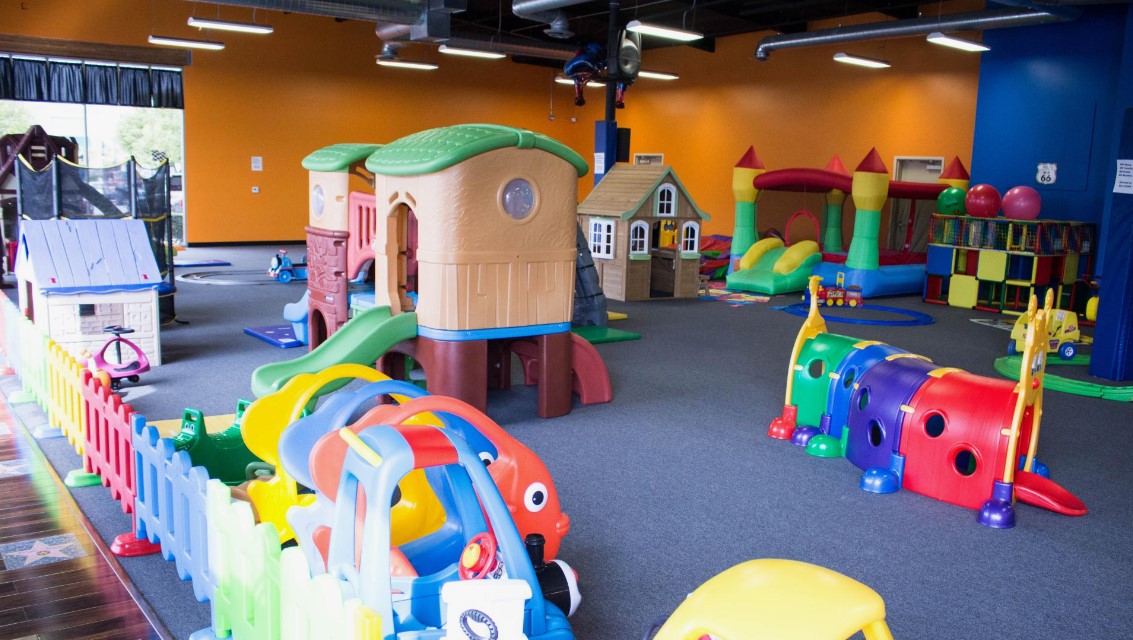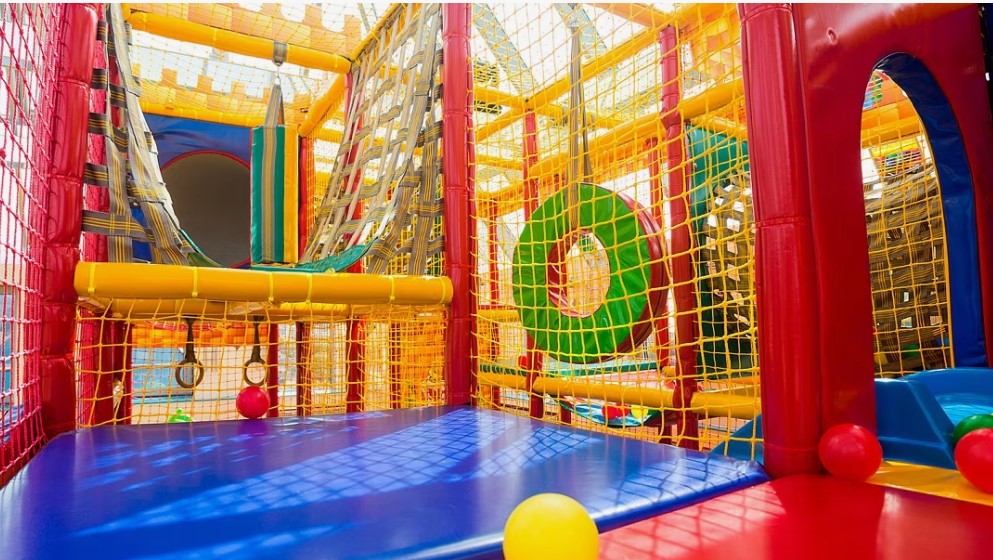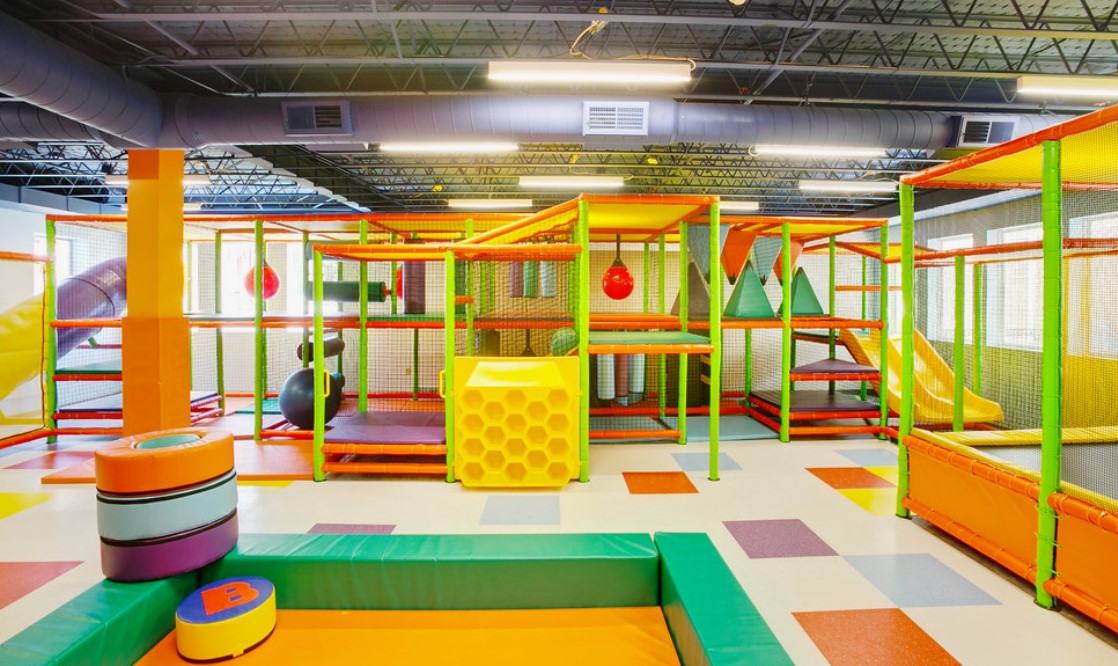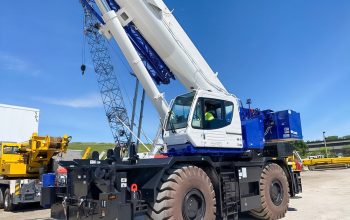Organizing a children’s indoor playground requires careful consideration of both practical and creative aspects. With these spaces becoming common in shopping malls, cafes, restaurants, hotels, salons, and even homes, designing a safe, engaging, and age-appropriate indoor children’s play area is essential. A well-thought-out play area can provide children with hours of entertainment and learning while allowing parents a worry-free break. Here’s a detailed guide to help you organize an “indoor children’s play area” effectively, covering everything from safety to variety and capacity planning.
Key Requirements for Children’s Play Areas
1. Safety First
Safety is paramount in any children’s play area. Kids are active and often uninhibited in play, making it essential that every structure, attraction, and surface is designed with safety in mind. Here are specific safety measures to consider:
🡪Rounded and Padded Corners: All structures should avoid sharp edges and hard surfaces. Adding padding to potential impact zones, such as the edges of tables, corners of walls, and structures, can help prevent injuries.
🡪Non-slip Flooring: Use rubber or foam mat flooring to provide a softer landing if a child falls. These materials are also slip-resistant, which is ideal for active play.
🡪Adequate Supervision: Even in self-guided play areas, ensure that at least one staff member or supervisor is present to monitor children’s safety.
🡪Maintenance of Equipment: Regular checks and maintenance ensure that equipment remains in optimal condition, preventing wear and tear that could lead to accidents.
2. Age Appropriateness
Children develop at different rates, and their interests and abilities vary based on age. It’s crucial to segment areas within the playground according to age to provide a tailored experience for each group:
🡪Toddlers (0-3 years): This area can include soft play equipment, smaller ball pits, and gentle climbing structures. The emphasis here is on safety and sensory exploration.
🡪Preschoolers (4-6 years): For this age group, you might include small trampolines, interactive screens with educational games, and simple puzzles.
🡪School-aged Children (7-10 years): This section can feature more challenging activities such as climbing walls, obstacle courses, and interactive digital screens that offer cognitive or strategic challenges.

3. Strategic Placement of Structures
Placing attractions in an intuitive and open layout enhances supervision and makes the play area feel more spacious and accessible:
🡪Open Sight Lines: Arrange equipment so that adults and supervisors can easily see across the play area. This means avoiding closed-off spaces or large structures that obstruct the view.
🡪Central and Peripheral Zones: Place high-energy activities like trampolines or climbing walls at the center, while calmer areas for quieter play, reading, or puzzles are better suited for the edges.
🡪Dedicated Check-in/Check-out Zone: For larger, commercial play areas, having a designated check-in and check-out spot enhances security and provides a clear entry and exit point.
4. Diverse Entertainment Options
Variety is essential in preventing boredom, especially if children will be using the play area for extended periods. Consider including a mix of entertainment types:
🡪Physical Activities: Trampolines, ball pits, and climbing walls encourage children to expend energy and develop motor skills.
🡪Quiet Play Zones: Add some quieter activities such as interactive tablets, reading nooks, and sensory play zones with tactile elements for children who prefer or need a break from more intense play.
🡪Creative Play Areas: Consider spaces where kids can explore their creativity, such as art stations, building blocks, or role-playing zones like a play kitchen or mini-grocery store.
🡪Educational Entertainment: Interactive screens with learning games, science displays, or DIY experiment areas can engage older children in educational play while keeping them entertained.
5. Planning for Capacity
Children’s play areas should be designed to handle a certain capacity comfortably. Overcrowding can lead to safety hazards and detracts from the play experience:
🡪Calculate Capacity Based on Area Size: A good rule of thumb is to allow a minimum of 20 square feet per child to ensure ample space for movement.
🡪Limitations by Equipment Type: Some equipment, like trampolines or climbing walls, has usage limits. Be sure to include clear signage to guide children and supervisors on how many can use each structure at a time.
🡪Traffic Flow: Design walkways and play zones with smooth traffic flow to prevent bottlenecks. This is especially crucial in commercial areas where children may move around freely.
Types of Children’s Play Areas
1. By Location
🡪Open (Outdoor) Play Areas: Typically found in parks, zoos, or amusement spaces, these areas use durable, weather-resistant equipment and provide more space for physical activities.
🡪Closed (Indoor) Play Areas: Located within shopping centers, cafes, or hotels, these are climate-controlled spaces with a focus on both physical and interactive activities that are suitable for indoor settings.
2. By Business Affiliation
🡪Standalone Commercial Playgrounds: These play areas are often found in shopping malls and are open to the general public.
🡪Business-Specific Play Areas: Some play zones are dedicated to a specific establishment, such as a café, salon, or hotel, and are accessible only to customers of that establishment.
3. By Adult Involvement
🡪Supervised Areas: These play zones have designated staff for monitoring, while children engage in self-directed play.
🡪Animator-Led Play Areas: Here, professional animators lead activities, games, and workshops, providing a more structured experience for children.
4. By Entertainment Focus
🡪Entertainment-Centric Areas: These spaces are filled with fun attractions like trampolines, slides, and ball pits.
🡪Educational-Focused Playgrounds: Areas that provide an educational element, like interactive screens or experiment stations, appeal to parents who want both play and learning.

Creating a Children’s Play Area at Home
For homes, a designated play area doesn’t need to be as extensive as a commercial playground, but can still be safe, engaging, and convenient for both children and parents. Some tips for setting up a home play area include:
🡪Choose Age-Appropriate Equipment: Consider the developmental stage of the child. Soft play mats, small climbing frames, and sensory toys work well for toddlers, while older children might enjoy a mini-climbing wall or table for arts and crafts.
🡪Safety is Key: Just like in commercial play areas, make sure there are no sharp corners or hard surfaces. Foam flooring or rugs help cushion falls.
🡪Maximize Space: Use vertical space by adding wall-mounted activities or storage for toys, creating more room for active play.
🡪Incorporate Educational Play: Consider a small reading nook, interactive screens with learning games, or even a chalkboard wall where children can draw.
Staffing and Supervision in Commercial Play Areas
For commercial playgrounds, staff play a critical role in ensuring safety and facilitating engagement:
🡪Safety Monitoring Staff: These employees supervise to ensure that rules are followed, and that children play safely.
🡪Trained Animators or Instructors: For areas offering structured activities or educational components, trained staff can guide children in interactive play, art, or science demonstrations.
🡪Regular Inspections and Cleaning: Staff should regularly inspect and clean equipment, especially in areas with high-touch surfaces, to maintain a hygienic environment.
Conclusion
Organizing a children’s indoor playground, whether in a commercial or residential setting, requires careful planning around safety, age appropriateness, variety, and capacity. With the right combination of play equipment, strategic layout, and engaging activities, an indoor playground can offer children a safe, fun, and enriching experience while giving parents peace of mind. Whether you’re setting up in a shopping mall or a living room, a well-designed play area provides a valuable and enjoyable space for children to explore, learn, and grow.

Cyclist, follower of Christ, ukulelist, Mad Men fan and Guest speaker. Operating at the fulcrum of aesthetics and elegance to craft meaningful ideas that endure. I work with Fortune 500 companies and startups.



